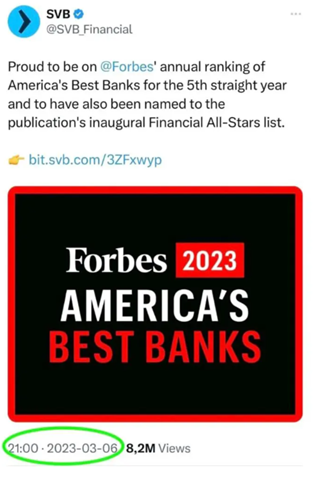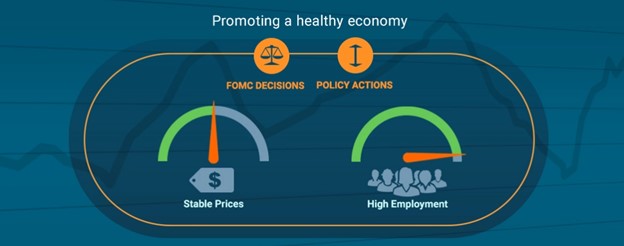
Banking on the Banks
For the last 12-18 months, the Federal Reserve (or Fed) has been in the spotlight. The focus on the Fed has only increased over the last few weeks as the situation unfolds with Silicon Valley Bank, Signature Bank, among others. Financial markets have been at the edge of their seats waiting to see how high interest rates would go. Economists were ready to dig into the Fed’s Summary of Economic Projections. But if you’ve ever wondered what the Federal Reserve (or Fed) is designed to do, what it was meant to do, and why we care about it, then this is for you.
The Fed can best be described as a grandparent.
In the middle of dinner, my three-year-old daughter will get up from the table, grab a piece of candy and ask her mom if she can have a piece. Her mother responds as expected, “After your dinner.” Then my daughter approaches me, asking the same question. “Can I have some candy?” My typical and most correct answer is, “Listen to your mother.” After having failed in two prior attempts, by daughter recalls the adage “If at first you don’t succeed, try, try again.” She then heads to a grandparent who breaks like a Kit-Kat bar and gives in to my daughter’s plea. The grandparent is the last resort. When mom and dad say “no”, the grandparent is the one to say, “why not?”
While this might be a little too harsh a criticism of Nana, Papa, Mawmaw, or PePaw, it’s a helpful way of understanding the original intent of the Fed, the lender of last resort.

Like many of our existing financial institutions, the Fed was spawned from a financial crisis called the Panic of 1907, a century before the Great Financial Crisis (’07-’09). This was before the FDIC and the Securities Exchange Commission. The Panic of 1907 shares a lot of similarities to the GFC. Failed speculative investments made by banks created a loss of confidence by their depositors, which created an old-fashioned bank run. The 1907 equivalent of the Lehman Brothers collapse in 2008 was the Knickerbocker Trust Company (doesn’t that just sound like a company from the early 1900s), which was the third largest trust company in New York.
By 1913, The Federal Reserve System was founded by an act of Congress and signed by President Woodrow Wilson to promote a stable banking system by becoming the “lender of last resort”. When banks can’t or won’t lend to one another to cover a run on deposits, the Fed would step in.
As the world has evolved over the last century, the Fed has evolved with it based on varying crises.
From the Great Depression, Congress allowed the President to revalue the USD in terms of gold and regulate the gold standard. It also launched the Federal Deposit Insurance Corporation, or FDIC. This system operates very similar to an insurance policy where member banks pay premiums to insure deposits.
During World War One, the Fed actively promoted war bonds to the public for the war effort.
During World War Two, the Fed agreed to prevent interest rates from rising during the war to ensure that the Treasury could borrow at low rates to finance defense spending.
But despite the evolution of the Fed, it still has limits. Think of the Fed like the team captain on a bobsled, he or she can turn the sled left or right a bit or put on and release the brakes, but he or she cannot make the sled go uphill.
Since the Great Inflation of the 1970s, the Fed has been tasked with a “dual mandate”:
- Maximizing Employment
- Price Stability (low inflation)

But both underpin the primary mandate of maintaining stability in the banking system.
The Fed works in collaboration with the US Treasury and FDIC to ensure that money supply is regulated, and support is provided to avoid or mitigate a potential crisis.
Regardless of your opinion on recent developments with Silicon Value Bank (SVB), First Republic, and Signature Bank, the positive outcome is the prompt response of regulators to step in and curb a potential panic.
The situation with these banks continues to unfold. We are only two weeks removed from the run on SVB and we have loads of Congressional hearings, internal, and external investigations forthcoming. But consensus, and our shared perspective, is that these are isolated incidents and not reflective of spillover into a broader crisis.
It’s an interesting story woven together by the Fed’s rapid increase in interest rates, poor leadership by bank executives, social media intensifying reaction, and a unique, concentrated customer base. Given recent events, I can’t help but point out the (*chef’s kiss*) irony to the idiom: “I’m banking on it.” Referring to dependence or reliability. I would also point out that the Federal Reserve is neither federal nor is it a reserve (but that’s a story for another day).
As such, we’re not ready to make a mountain out of this molehill. Whether the support by the Fed, Treasury, and FDIC was too much or too little is a different conversation. What should be comforting is their ability to act expeditiously when everything moves at the speed of a tweet.
Thank you for your continued trust and confidence.
Tyler Martin, CFP®, CPWA®

